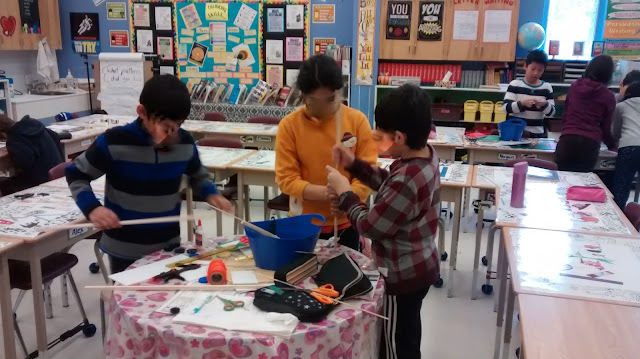It's almost back to school time and most teachers don't want to even begin to think about going back. I have been thinking. . . but not about going back, but about combined grades. There have been big changes in my school this year and most teachers will have a combined (or split) grade next year. Once upon a time, years ago in my teaching career, I was referred to as the "Queen of Combined Grades". I had taught many years in a combined grade setting and wrote some curriculum documents for the Ministry of Education about how to teach in a combined grade. When I worked as an instructional leader/coach, I gave a series of workshops about teaching combined grades, and I often went into to schools to help teachers plan for their combined grades.
One of the strategies I always suggested when I was giving workshops or working in classrooms was to teach using centres. When I was teaching in the classroom, I realized that I could have students working at centres for math and science which would allow me to go around and observe, discuss and assess. I would find materials that would work in bins or tubs (often from my board's science kits) and then set up the centres. The kids would be given periods to rotate through the centres and experience hands on, minds on science. The hard part was always finding activities and investigations that would work for both grades, both topics AND work in centres.
After spending at least the past decade thinking "It would great if someone would just go ahead and make combined grade centres for science and technology!", I decided to create my own. Below you can see some of students working on a centre from my Forces Acting on Structures and Mechanisms unit.
I am the first to admit that you have to put some effort into collecting the materials and putting the centres together, but once you have it done, your students (and you) will reap the benefits. Students can work at developing the same skills, while each group is investigating the grade level curriculum topic for their grade. The centres I have created include 10 different centres for each grade. These include a variety of hands-on, minds-on investigations and activities geared towards engaging students in the junior division.
 |
| Grade 5 Let's Explore Centre Card |
 |
| Grade 4 Let's Explore Centre Card |
I suggest that you introduce centres to your students early in the year. I do not use ONLY centres to teach my program. A variety of approaches keep students engaged and learning. I like to show videos and often use powerpoint presentations to introduce a unit. I have also had presentations by groups such as Scientists in School to kick off or wrap up a unit. I also introduce and teach vocabulary as an essential part of student success in communicating their learning. The use of a word wall in a classroom can be a highly effective teaching strategy to improve literacy skills. Word wall activities encourage active student participation. Gestures, such as pointing to key words during a lesson, offer visual reinforcement which can be very helpful for students.
I created word walls to go along with all of my science and technology centres. I know my students are more likely to use the correct terminology if I introduce it to them at the beginning of the unit. You can have students create their own visual dictionaries in their science notebooks, or you could print out the word wall cards and have them glue into an interactive notebook. The choices for use are endless. I also find these vocabulary cards to be very effective with ESL and ELL learners.
If you are looking to try out some combined grade science and technology centres this year just click on the image above. Each MEGA BUNDLE includes SCIENCE CENTRES for BOTH grades and ILLUSTRATED WORD WALLS for both grades as well. These bundles are ready for immediate use in your classroom!
Don't teach a COMBINED GRADE? That's okay, all of my SCIENCE CENTRES and ILLUSTRATED WORD WALLS are available for individual grades as well.










